|
This section contains 4,314 words (approx. 15 pages at 300 words per page) |

|
The Dge-lugs (pronounced "geluk") tradition of Tibetan Buddhism, the tradition followed by the Dalai Lamas, traces its origins to the towering Tibetan philosopher and monastic reformer Tsong kha pa (1357–1419) and his two closest disciples, Rgyal-tshab (pronounced "gyeltsap") (1364–1432) and Mkhas grub (pronounced "kaydrup") (1358–1438), whose views have come to represent orthodoxy for the tradition. According to traditional hagiographies, Tsong kha pa studied with more than sixty of the greatest scholars in Tibet during his early life and went on to compose numerous treatises and commentaries on the entire spectrum of Buddhist thought and practice, leaving a set of collected works that numbers nineteen volumes. His philosophical works address virtually all the major topics in Buddhist philosophical discourse, including issues of ontology, metaphysics, epistemology, logic, soteriology, and hermeneutics, among others. Aided by historical and political conditions Tsong kha pa's works, those of his disciples, and the monastic and educational systems he...
|
This section contains 4,314 words (approx. 15 pages at 300 words per page) |

|


